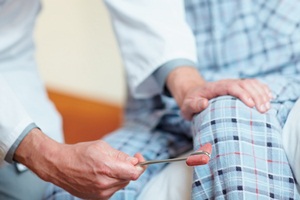Many of us probably recall our childhood visits to the pediatrician. And some of us might even remember being amused and surprised when the doctor used a little hammer to tap just below our knee and our lower leg jumped in response ALL BY ITSELF! 
Later in life, we may have learned that physicians use this simple test to judge the health of our nervous system. Even more specifically, we may have learned that they use it to test one of our many reflexes-the patellar or knee-jerk reflex. Here are our chiropractic services that we offer aside from just reflexes and your nervous system.
But what exactly are reflexes? In medical terms, a reflex is described as a “sensorimotor arc”. This arc occurs when a sensory receptor neuron (such as a pain receptor in the skin) receives a stimulus and sends a signal to a motor neuron in the central nervous system (spinal cord). The motor neuron then sends a response to the proper effector (a muscle or gland) without needing to involve the brain. So our body’s reaction occurs automatically without us having to think about it consciously.
Our reflexes come into play in a variety of ways and serve a variety of purposes from our earliest days. Newborn babies have a considerably larger number of reflexes than adults. These reflexes evolved over time to help ensure the survival of the infant. Rooting, sucking and hand-to-mouth movements are all reflexive in a baby so that the infant is more likely to get enough food.
Adults have reflexes too, but some are obvious and some are not. For example, reflexes help us maintain our body’s internal temperature. If the body is exposed to cold, it shivers to maintain a core temperature of 98.6°F. If it’s hot outside, the body sweats to keep itself from overheating. We also depend on our reflexes to maintain our body’s position and balance. Our muscles have a constant awareness of their shape. When the muscle changes shape by stretching, an automatic signal is sent to adjust the muscle shape to maintain our posture. It is a signal that happens so quickly that we are not aware of the continual adjustments our muscles are making in order to keep us upright.
There are countless other examples. Our pupils dilate in the presence of low light. We blink when debris is flying toward our eyes. Our mouths water at the scent of food cooking. Some reflex reactions are more dramatic, such as pulling your hand back quickly when you touch a hot surface, ducking to avoid a blow and extending your hands to brace for a fall.
A doctor may perform reflex testing if he or she suspects any nerve damage. Reflex testing can be used to help determine the presence of a spinal cord injury or neuromuscular disease. Different parts of the body can be gently struck with a mallet, and the type of response points to the type of damage. A response that is absent or weak can indicate peripheral neuropathy, motor neuron disease or muscle disease. Conversely, an excessive response may indicate damage to the spinal cord above the area responsible for hyperactivity. A response that is different on each side of the body (one knee reacts more or less than the other, for instance), may be an indication of the early onset of a degenerative nerve disease or an acute trauma.
Our reflexes can provide a useful window into the health of our nervous system. And the next time you get a checkup at the doctor you will know what that little hammer is for! If you are a first time patient please contact us at Chicago Chiropractic and schedule your appointment.
Chicago Chiropractic
A Unique, Multidisciplinary Approach to Pain Management
X
